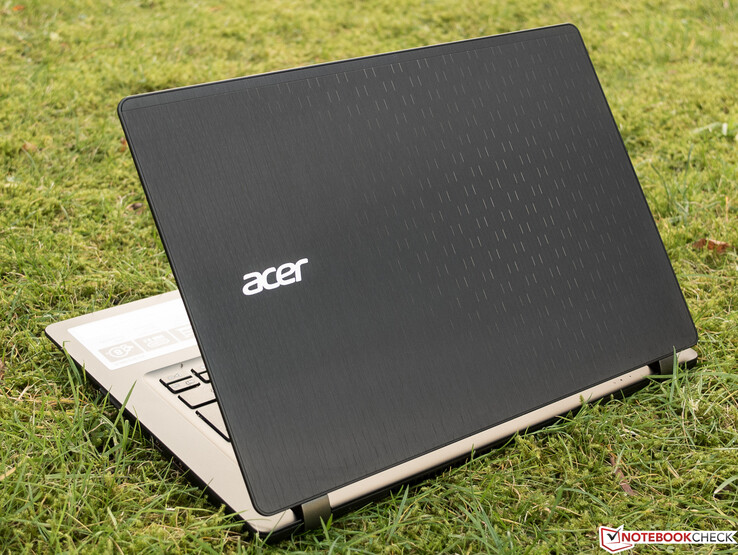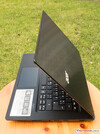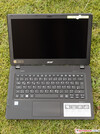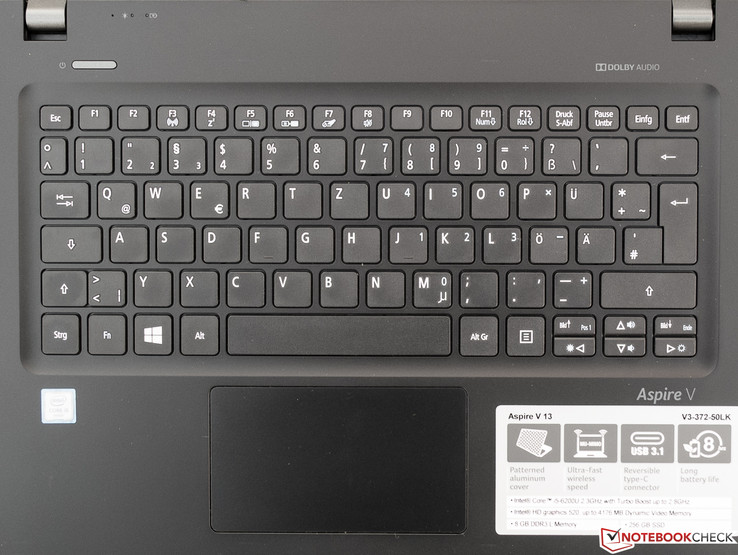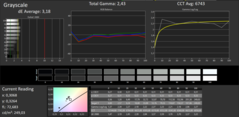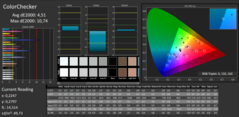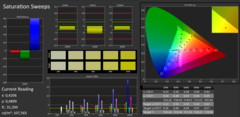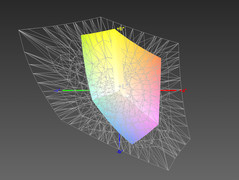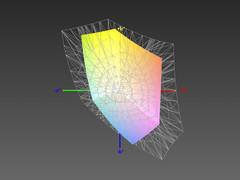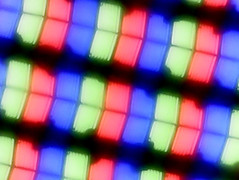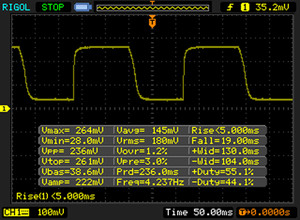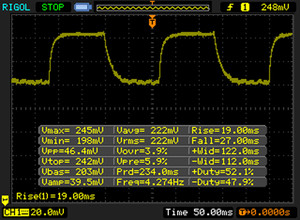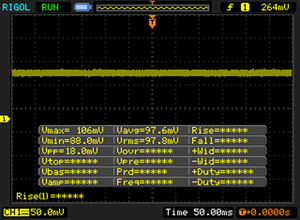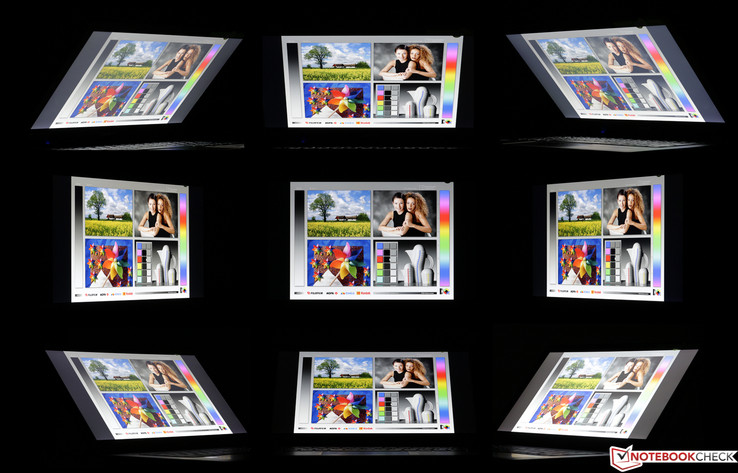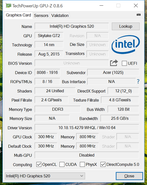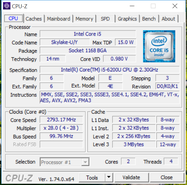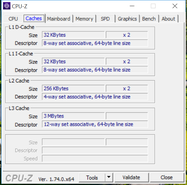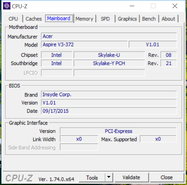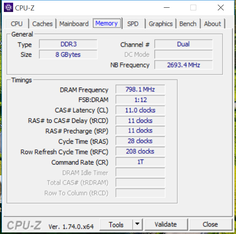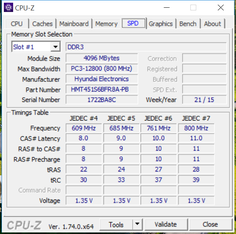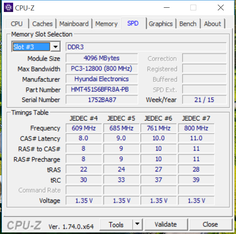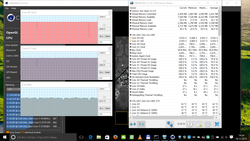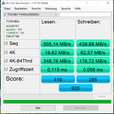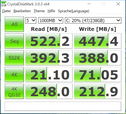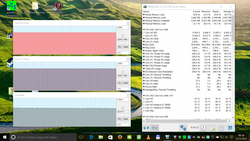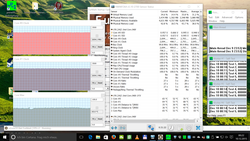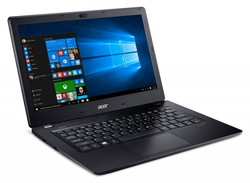Acer Aspire V3-372 Subnotebook Review

For the original German review, see here.
Acer's popular Aspire V 13 lineup generates handy, 13-inch laptops that are situated in the mid-price range. The new V3-372 models have now been added to the lineup. Six different versions could be admired in a major Berlin-based price comparison engine. They are all furnished with the cutting edge Intel Core i5-6200U Skylake processor. While the Acer Aspire V3-372-50LK review sample comes with a non-glare Full HD screen for just below 800 Euros (~$868), the manufacturer installs a screen with 1366x768 pixels in two other versions. 4 or 8 GB of working memory can be selected, and at least four of the models sport a 256 GB SSD like the review sample. The operating system is always Windows 10 Home. Dedicated graphics cards are not intended. We last tested the Broadwell-based Aspire V3-371-58DJ predecessor that is quite similar with the current models in February 2015.
Asus has dominated the market for highly mobile, 13-inch devices for years with its countless but usually more expensive Zenbook models. Buyers who are willing to spend a few hundred Euros more should also attentively look at the premium HP Envy 13 and Dell XPS 13 lineups. One of the least expensive 13-inch Zenbooks, the fanless UX305CA-FC037T that we tested in the US UX305CA (M-6Y30) version, starts at a price of around 650 Euros (~$705), and we use it as the preliminary comparison device despite its weaker engine. It at least also offers a 256 GB SSD and Full HD screen. The third device in this round is HP's latest 13-inch ProBook 430 G3 with a TN screen with 1366x768 pixels and conventional hard drive. Like in Acer's laptop, an i5-6200U alongside the integrated Intel HD 520 graphics unit clocks inside. Its price starts at approximately 630 Euros (~$684).
Case
The tester finds the 13-inch format an ideal compromise of mobility and acceptable screen and keyboard size. At almost 20 mm, Acer's Aspire V3-372 is even approximately 2 mm thinner than the already slim V3-371 predecessor. However, its width, depth and weight have not changed. The casings of both generations look very similar. Acer again basically relies on black, high-quality looking plastic and a display back composed of aluminum. The latter once again exhibits the attractive design that Acer calls "elegant nano-imprint pattering."
Unfortunately, this surface proves to be particularly highly susceptible for fingerprints. That is also true for the base's sleek and matte upper side with the lightly lowered keyboard to a lesser degree. The lid does not close flush with the base's upper side in the rear in a closed state. A gap of a good 1.5 cm remains, always making the LEDs under the screen visible. The construction gives - in the tester's opinion - the very attractive casing a unique look. However, there are some more open, slightly sharp edges than on conventional casings, which could reduce carrying comfort and make it difficult to slip the laptop into a bag.
The thin plastic base defied our warping attempts, accompanied by minor cracking noises, with a surprising amount of resistance which underlines the overall very solid impression. The apparently next to impeccable build matches to that. Unfortunately, the relatively pressure-resistant lid cannot be opened without counter-force. The lid gradually opens further when the V3 is on the lap and is shaken strongly (e.g. in a car on cobblestones). The lid wobbles for a few seconds when the laptop is placed on a solid surface and is bumped. The representative casing leaves an overall very good impression.
Connectivity
The connectivity just fulfills the minimum requirements for interfaces. At least a fold-out Ethernet port for Gigabit LAN is available for stationary use. More than one external monitor cannot be connected since the HDMI port is the only video-out. Unfortunately, two of the four USB ports still operate in the outdated 2.0 standard. However, one of both USB 3.0 ports is installed as USB Type C so that, for example, Nexus' new smartphones or OnePlus' 2 can be connected and recharged without an adapter.
As usual, sequential read was possible at almost 100 MB/s in conjunction with the tester's external USB 3.0 hard drive. Acer places the interfaces in the center of the sides, which is still better than far front where connected cables and flash drives could get in the way. Users who require VGA, NFC, TPM and a fingerprint reader should take a closer look at the perfectly equipped HP ProBook 430 G3 P5T00ES comparison device. We test the card reader's performance with our Toshiba Exceria Pro SDXC 64 GB UHS-II reference card. It is middling with a maximum transfer rate of only 27 MB/s in copying large data blocks. A maximum of just 15 MB/s can be expected when transferring JPG image files at approximately 5 MB each.
Communication
The installed Atheros/Qualcomm CA6174 module supports the no longer brand new ac standard in addition to the widespread IEEE 802.11 g (2.4 GHz) and n (2.4 and 5 GHz). It exclusively uses the considerably less frequented 5 GHz band. Since Bluetooth 4.0 is also installed, the user is up-to-date in terms of wireless communication.
Accessories
In addition to the power supply, the usual setup and safety notes (no warranty information) are in the box. Instructions for BYOC (build your own cloud) for using the PC as a cloud server are also included. The user will be dependent on the hopefully still undamaged recovery partition should it become necessary to reinstall the system.
Maintenance
Acer apparently wants a part of the earnings made on possible maintenance work and thus completely thwarts the user from accessing the innards. A maintenance hatch is just as absent as is the possibility to replace the battery. Users willing to risk the warranty and guaranty can release the multitude of screws on the underside of the beveled tray and try to lever off the base's upper side.
Warranty
As usual, Acer includes a two-year pick-up and return service in Germany. Details and conditions can be read here. The implied warranty is naturally also valid.
Input Devices
Touchpad
Like in the Aspire V3-371, the absolutely sleek ClickPad has some play and tends to clatter lightly when tapping around on it. It stutters when swiping upward with a lightly moist finger. The agreeably sized surface in view of the casing's small format has a zone of approximately half-a-centimeter on the left and right that does not respond to touch. The accuracy and responsiveness are inconspicuous in a positive sense. Moving icons around on the desktop via double tap (drag & drop) was always easily possible.
A medium drop, firm yet pleasantly set resistance, and clearly palpable and audible feedback owed to the crisp pressure point characterize the replacement keys. The ELAN device does not have a dedicated setting menu so that gestures with up to four fingers have to be configured via Windows 10. However, some configuration options have been added since Windows 7.
Keyboard
The tester did not type much on the actually still useful keyboard in Acer's Aspire. The quite important space bar lastingly wedged in our review sample, making keyboard use torturous. Since we always rate the device made available to us, we massively downgraded the keyboard, which is evident in the total rating. Acer's quality monitoring failed here.
The limited room does not allow for a numpad, and some keys like return and arrow keys have been scaled down compared with desktop keyboards. Otherwise, the layout largely corresponds to the usual standard. The manufacturer spaced the flat, roughened and impeccably lettered but not backlit keys sufficiently. Unfortunately, the typing feel on the seemingly rather unstable construction is inconsistent. Particularly the center yields under little force. Some keys have a crisp enough pressure point, others do not. Some keys have a nice stroke, but it is too soft or too undefined in others. The keys feature a short drop. The sooner restrained noise development will hardly be a disturbing factor. Overall, the keyboard is not appropriate in view of the price for Acer's V3 and is likely its biggest shortcoming.
Display
Matching the price, Acer opted for a matte IPS screen with a Full HD resolution. The subnotebooks we tested over the past 12 months have an average brightness (center) of 320 cd/m², which the review sample clearly undercuts with 250 cd/m². Since mobile devices are often used in varying light conditions, a slightly higher brightness would not have hurt for outdoor use. The very decent measured illumination of 87% looks better and corresponds to our subjective impression of a largely homogeneous illumination. Hints of backlight bleeding are only seen at the lower edge on a completely black screen. That, however, will not be visible in routine use.
| |||||||||||||||||||||||||
Brightness Distribution: 87 %
Center on Battery: 250 cd/m²
Contrast: 581:1 (Black: 0.43 cd/m²)
ΔE ColorChecker Calman: 4.51 | ∀{0.5-29.43 Ø4.78}
ΔE Greyscale Calman: 3.18 | ∀{0.09-98 Ø5}
58% sRGB (Argyll 1.6.3 3D)
37% AdobeRGB 1998 (Argyll 1.6.3 3D)
40.35% AdobeRGB 1998 (Argyll 3D)
58.7% sRGB (Argyll 3D)
39.05% Display P3 (Argyll 3D)
Gamma: 2.43
CCT: 6743 K
Although the black level of 0.43 cd/m² is not particularly low, it does not give reason for complaint. That is also true for our subjective impression: We have seen deeper black, but not often on IPS screens. Since the contrast results from the black level and maximum brightness, only a below average yet still feasible 581:1 is achieved. Our Asus Zenbook UX305CA accomplishes a fantastic 1122:1, which is owed to the higher brightness and lower black level. It is the opposite for the TN screen of HP's ProBook 430 G3 that does not surpass a poor 299:1.
Acer's Aspire V3 takes the first place in color accuracy. DeltaE rates of around 5 and 3 are quite close to ideal. The Zenbook only does a middling job here, but the ProBook takes the cake with a DeltaE of 12 and 13, and it also has a tremendous bluish tint in delivery state. (Semi) professional image editors place value in the highest possible coverage of the large AdobeRGB color space and will thus not be satisfied with Acer's Aspire. Like HP's laptop, it only achieves rates of around 35% here. The superb screen in Asus' laptop does a much better job despite the low price. It almost completely covers the much smaller yet omnipresent sRGB color space by 65%.
| Acer Aspire V3-372-50LK | Asus Zenbook UX305CA-EHM1 | HP ProBook 430 G3 P5T00ES | |
|---|---|---|---|
| Display | 60% | -8% | |
| Display P3 Coverage (%) | 39.05 | 64.5 65% | 35.87 -8% |
| sRGB Coverage (%) | 58.7 | 90.4 54% | 54 -8% |
| AdobeRGB 1998 Coverage (%) | 40.35 | 65.5 62% | 37.06 -8% |
| Response Times | 8% | -28% | |
| Response Time Grey 50% / Grey 80% * (ms) | 46 ? | 37.6 ? 18% | 54.4 ? -18% |
| Response Time Black / White * (ms) | 24 ? | 24.8 ? -3% | 32.8 ? -37% |
| PWM Frequency (Hz) | 201.6 ? | 192 ? | |
| Screen | 16% | -72% | |
| Brightness middle (cd/m²) | 250 | 324.3 30% | 212 -15% |
| Brightness (cd/m²) | 247 | 314 27% | 205 -17% |
| Brightness Distribution (%) | 87 | 93 7% | 90 3% |
| Black Level * (cd/m²) | 0.43 | 0.289 33% | 0.71 -65% |
| Contrast (:1) | 581 | 1122 93% | 299 -49% |
| Colorchecker dE 2000 * | 4.51 | 6.03 -34% | 12.06 -167% |
| Greyscale dE 2000 * | 3.18 | 7.89 -148% | 13.41 -322% |
| Gamma | 2.43 91% | 2.08 106% | 2.41 91% |
| CCT | 6743 96% | 6490 100% | 15382 42% |
| Color Space (Percent of AdobeRGB 1998) (%) | 37 | 65.46 77% | 34.3 -7% |
| Color Space (Percent of sRGB) (%) | 58 | 90.36 56% | 54.2 -7% |
| Total Average (Program / Settings) | 28% /
24% | -36% /
-52% |
* ... smaller is better
We tested the outdoor legibility on a lightly overcast day. Despite the just still sufficient brightness for such undertakings, the content was usually still well-legible on our walk through the garden. As can be seen in the first screenshot, even a matte screen can be aligned toward the sky until nothing can be recognized. Ideally, a building was behind the tester in the second screenshot.
Display Response Times
| ↔ Response Time Black to White | ||
|---|---|---|
| 24 ms ... rise ↗ and fall ↘ combined | ↗ 5 ms rise | |
| ↘ 19 ms fall | ||
| The screen shows good response rates in our tests, but may be too slow for competitive gamers. In comparison, all tested devices range from 0.1 (minimum) to 240 (maximum) ms. » 53 % of all devices are better. This means that the measured response time is worse than the average of all tested devices (20.2 ms). | ||
| ↔ Response Time 50% Grey to 80% Grey | ||
| 46 ms ... rise ↗ and fall ↘ combined | ↗ 19 ms rise | |
| ↘ 27 ms fall | ||
| The screen shows slow response rates in our tests and will be unsatisfactory for gamers. In comparison, all tested devices range from 0.165 (minimum) to 636 (maximum) ms. » 78 % of all devices are better. This means that the measured response time is worse than the average of all tested devices (31.6 ms). | ||
Screen Flickering / PWM (Pulse-Width Modulation)
| Screen flickering / PWM not detected | |||
In comparison: 53 % of all tested devices do not use PWM to dim the display. If PWM was detected, an average of 8111 (minimum: 5 - maximum: 343500) Hz was measured. | |||
The largely impeccable viewing angle stability improves the, to this point, only middling impression for IPS conditions. Acer's Aspire V3-372-50LK provides a lot of elbowroom in front of the screen. The usual brightness and contrast losses are kept within tight limits when looking from below or from the sides. Black only seems too bright and a slightly inverted image impression only evolves when looking from above.
Performance
3D gaming will not come into question due to the lack of a graphics card. Highly parallelized applications, such as 3D rendering, will hardly run on subnotebooks. Thus, the frugal, Hyper-Threading-capable dual-core alongside 8 GB of dual-channel RAM and fast SSD is easily enough to cope with typical application scenarios for this device category and to always ensure a smooth operating experience. Even demanding and memory-driven Photoshop projects with many high-resolution levels should hardly bring our Aspire to its limits.
Processor
Intel's Core i5-6200U (2 x 2.3 - 2.8 GHz, Hyper-Threading, TDP 15 W) is the Skylake CPU that will presumably achieve the highest quantities being the successor of the very popular i5-4200U and i5-5200U. Thus, it will likely be installed in countless laptops of every size in the next months. Its low TDP that can even be reduced to 7.5 watts with performance losses makes it suitable for particularly compact devices, such as our V3. The base clock is 2.3 GHz, which can be increased up to 2.7 GHz via Turbo when both cores are loaded. 2.8 GHz is exclusively used for single threads that only require one core. Skylake also offers support for fast DDR4 memories for the first time, and it should also clearly benefit from that.
Although Intel renewed the entire micro-architecture in the course of a so-called "tick", the Skylake's strength is not the approximately 5 to 10% higher per-MHz performance compared with its predecessors. It is sooner the noticeably improved energy efficiency over the Haswell chips still built in the 22 nm process. Our previous tests with Skylake processors makes us want more because we could in fact often report about low power consumption, long battery runtimes, and quiet and cool utilization.
The CPU in the review sample presents the expected performance in the Cinebench multi-core tests but falls behind by approximately 15% for no apparent reason in the single-core tests. That will unlikely be noticed in routine use. The tremendously frugal and passively cool-able Intel Core m3-6Y30 (2 x 0.9 - 2.2 GHz, Hyper-Threading, TDP 4.5 W) Skylake chip in the Zenbook does not lag behind as much. Its performance is still enough for most subnotebook purposes, but it can no longer keep up during prolonged, high load. The i5 processor can stably maintain the specified clock of 2.7 GHz in our (multi-core) Cinebench loop and perfectly utilize the Turbo in still realistic conditions. The Cinebench R15 multi-core score does not change in battery mode.
| Cinebench R11.5 | |
| CPU Multi 64Bit (sort by value) | |
| Acer Aspire V3-372-50LK | |
| Asus Zenbook UX305CA-EHM1 | |
| HP ProBook 430 G3 P5T00ES | |
| CPU Single 64Bit (sort by value) | |
| Acer Aspire V3-372-50LK | |
| Asus Zenbook UX305CA-EHM1 | |
| HP ProBook 430 G3 P5T00ES | |
| Cinebench R15 | |
| CPU Multi 64Bit (sort by value) | |
| Acer Aspire V3-372-50LK | |
| Asus Zenbook UX305CA-EHM1 | |
| HP ProBook 430 G3 P5T00ES | |
| CPU Single 64Bit (sort by value) | |
| Acer Aspire V3-372-50LK | |
| Asus Zenbook UX305CA-EHM1 | |
| HP ProBook 430 G3 P5T00ES | |
| Cinebench R10 | |
| Rendering Multiple CPUs 64Bit (sort by value) | |
| Asus Zenbook UX305CA-EHM1 | |
| Rendering Single CPUs 64Bit (sort by value) | |
| Asus Zenbook UX305CA-EHM1 | |
System Performance
Acer's Aspire V3-372-50LK remains to be the winner in our comparison field when looking at the tried PCMark 7. Although the Zenbook also sports an SSD, its slower CPU prevents it from keeping up. In contrast to PCMark 8, the benchmark highly prioritizes the storage device's performance in the total performance assessment. Thus, the ProBook lags far behind in third place. PCMark 8 sees the three devices closer together, and Asus in last place.
Matching the review sample's high scores, the always smooth handling was a lot of fun. That, as so often, is primarily owed to the SSD. Programs opened in no time and Windows 10 booted quickly. Heavy multitasking with multiple simultaneously opened Chrome tabs was no problem. A difference to processors with four physical cores only became evident when we used the device while running a stress test, such as Prime95.
| PCMark 8 | |
| Home Score Accelerated v2 (sort by value) | |
| Acer Aspire V3-372-50LK | |
| Asus Zenbook UX305CA-EHM1 | |
| HP ProBook 430 G3 P5T00ES | |
| Work Score Accelerated v2 (sort by value) | |
| Acer Aspire V3-372-50LK | |
| Asus Zenbook UX305CA-EHM1 | |
| HP ProBook 430 G3 P5T00ES | |
| PCMark 7 Score | 5197 points | |
| PCMark 8 Home Score Accelerated v2 | 3209 points | |
| PCMark 8 Work Score Accelerated v2 | 4155 points | |
Help | ||
Storage Device
Modern SSDs are increasingly being restrained by the limit of approximately 500 MB/s specified for SATA 3, as is the case here. Whether a higher throughput would be noticed in practice may be questioned. We expect at least 20 MB/s from a conventional HDD when reading small, random 4K blocks. Toshiba's SSD in the review sample unfortunately barely surpasses that. Strong rivals achieve up to 50% more here, and the Micron SSD in the Zenbook has a lead of 31% according to AS SSD. Naturally, the relatively slow drive even for HDDs in the ProBook does not stand a chance.
Graphics Card
For years, Intel has focused on improving the energy efficiency of its new processor generations and is satisfied with small performance increases that are within a one-digit percent range from one generation to the next instead. It looks similar with the CPU-integrated GPUs, such as the Intel HD 520 in the Core i5-6200U. It does not have a dedicated RAM and has to share the working memory with the CPU. The performance clearly benefits from the dual-channel RAM here. The performance gain of the fast, Skylake-exclusive DDR4 memory is even more striking.
From a technical point of view, the chip that clocks at up to 1050 MHz supports DirectX 12, but it is much too weak to render games that utilize it or even "only" DirectX 11 smoothly. The GPU's performance also depends on the CPU it is integrated in. The unit in our review sample belongs to the fastest in our database and is only surpassed by at most 5%. The 520 in our HP ProBook even lags behind by 16% in 3DMark 11. Rerunning 3DMark 11 in battery mode results in the same total score as in AC mode.
| 3DMark 11 - 1280x720 Performance GPU (sort by value) | |
| Acer Aspire V3-372-50LK | |
| Asus Zenbook UX305CA-EHM1 | |
| HP ProBook 430 G3 P5T00ES | |
| 3DMark | |
| 1280x720 Ice Storm Standard Graphics (sort by value) | |
| Acer Aspire V3-372-50LK | |
| Asus Zenbook UX305CA-EHM1 | |
| HP ProBook 430 G3 P5T00ES | |
| 1280x720 Cloud Gate Standard Graphics (sort by value) | |
| Acer Aspire V3-372-50LK | |
| Asus Zenbook UX305CA-EHM1 | |
| HP ProBook 430 G3 P5T00ES | |
| 3DMark 11 Performance | 1487 points | |
| 3DMark Ice Storm Standard Score | 56687 points | |
| 3DMark Cloud Gate Standard Score | 5833 points | |
Help | ||
Gaming Performance
Like the former Intel HD 5500, up-to-date, graphically attractive 3D games are not possible with this GPU. Less-demanding games like FIFA 16, The Sims 4, Diablo III or StarCraft 2, whose maker has just released the second and final add-on Legacy of the Void, are playable. These games run smoothly in medium and even high settings in some rare cases. Our FAQ section provides a multitude of benchmarks concerning mobile graphics cards.
| low | med. | high | ultra | |
|---|---|---|---|---|
| Metro: Last Light (2013) | 28.7 | 22.6 | 14.4 | |
| Battlefield 4 (2013) | 39.8 | 28.2 | 18.6 | 5.6 |
| Thief (2014) | 24.8 | 14.2 | 11.7 | |
| Middle-earth: Shadow of Mordor (2014) | 29.8 | 19 | 10 | |
| The Witcher 3 (2015) | 12 | 8.1 | ||
| Mad Max (2015) | 20.5 | 10 | ||
| Anno 2205 (2015) | 32.2 | 16.2 | 6.4 | |
| Rainbow Six Siege (2015) | 32.6 | 19.1 |
Emissions
System Noise
Quiet, quieter, V3. The fan remains silent during low load (idle). We measured 31.5 dB that the ambient noises produced. It was a low 0.8 dB more during prolonged maximum load. Based on that, we will not go in-depth about the fan's behavior. Acer's laptop was only just still audible with some effort even during unrealistic extreme conditions.
Noise level
| Idle |
| 31.5 / 31.5 / 31.5 dB(A) |
| Load |
| 32.4 / 32.3 dB(A) |
 | ||
30 dB silent 40 dB(A) audible 50 dB(A) loud |
||
min: | ||
Temperature
Will the extremely quiet operating noise take its toll on surface temperatures? That has to be affirmed. The maximum temperature of 53 °C on the underside is unusually high for a modern laptop based on a 15-watt CPU. That could prevent sensitive users from performing long stress tests with the device on the lap. Since no-one would actually do that, we would like to point out that problems will never occur on a table. The wrist-rest area never surpassed an agreeable 24 °C.
Our stress tests via Prime95 and FurMark (GPU) could not stop the CPU from running at the specified Turbo speed of 2.7 GHz even during simultaneous permanent use. The core temperatures were far from critical. That is not a matter of course since the CPU and GPU share the not very lush TDP of 15 watts. Acer can pride itself on implementing the processor perfectly.
| Acer Aspire V3-372-50LK HD Graphics 520, 6200U, Toshiba HG6 THNSNJ256G8NU | Asus Zenbook UX305CA-EHM1 HD Graphics 515, 6Y30, Micron M600 MTFDDAV256MBF M.2 | HP ProBook 430 G3 P5T00ES HD Graphics 520, 6200U, Hitachi Travelstar Z7K500 HTS725050A7E630 | |
|---|---|---|---|
| Heat | 28% | 5% | |
| Maximum Upper Side * (°C) | 49.3 | 34.6 30% | 42.1 15% |
| Maximum Bottom * (°C) | 53.3 | 35.2 34% | 44.1 17% |
| Idle Upper Side * (°C) | 28.2 | 22.6 20% | 31.1 -10% |
| Idle Bottom * (°C) | 32.6 | 23.4 28% | 32.9 -1% |
* ... smaller is better
(-) The maximum temperature on the upper side is 49.3 °C / 121 F, compared to the average of 35.9 °C / 97 F, ranging from 21.4 to 59 °C for the class Subnotebook.
(-) The bottom heats up to a maximum of 53.3 °C / 128 F, compared to the average of 39.3 °C / 103 F
(+) In idle usage, the average temperature for the upper side is 25 °C / 77 F, compared to the device average of 30.8 °C / 87 F.
(+) The palmrests and touchpad are cooler than skin temperature with a maximum of 23 °C / 73.4 F and are therefore cool to the touch.
(+) The average temperature of the palmrest area of similar devices was 28.2 °C / 82.8 F (+5.2 °C / 9.4 F).
Speakers
We were surprised that the Dolby/Realtek sound system in the small Acer laptop is in fact convincing. The device rendered our usual test songs clearly and naturally using the well-balanced "Music" preset on a table. However, as so often a well-concealed emphasis of the mids is evident here, and the lack of volume prevents real basses. Nevertheless, there are hints of dynamic, and even a certain degree of surround in corresponding tracks. The maximum volume is sufficient for medium-sized rooms.
The differentiation of instruments only suffers lightly when many loud instruments, such as guitars, bass and drums are present (Slayer: "Repentless"). We could not provoke distortions, piercingly high tones or volume fluctuations. Speech was well-intelligible and natural. Overall, the V3 gave a decent performance that many bigger laptops could take as an example.
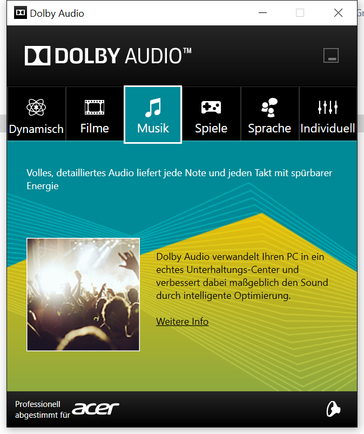
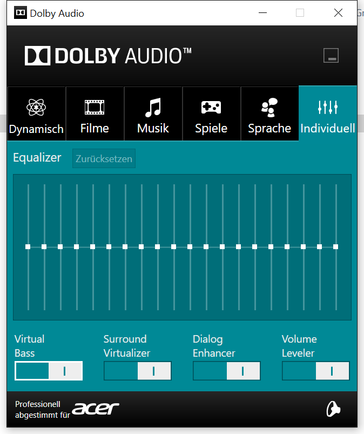
Energy Management
Power Consumption
We first have to point to the review sample's unfortunately much too high consumption in a turned-off state and standby. Acer messed up in view of 0.4 and 0.6 watts. It is still midfield during use compared with the 13-inch subnotebooks tested in the past twelve months. However, we still lack data for comparing with other 6200U subnotebooks. The 45-watt power supply is sufficient for recharging the V3 at the side in every load state.
| Off / Standby | |
| Idle | |
| Load |
|
Key:
min: | |
Battery Runtime
In view of the well-comparable battery capacities of the three subnotebooks (Acer: 51 Wh, Asus: 45 Wh, HP: 44 Wh), it would make sense to make a direct comparison of the runtimes. All devices fulfill their mobility claim and are real long-runners with superb runtimes of around six hours in the real-world Wi-Fi test that we perform using energy-saving mode, disabled Bluetooth and a brightness of approximately 150 cd/m² (our test criteria). The UX305CA alongside its extremely frugal 7.5 watt CPU can place itself at the front in load and idle mode, as well as in the Wi-Fi test.
| Acer Aspire V3-372-50LK HD Graphics 520, 6200U, Toshiba HG6 THNSNJ256G8NU | Asus Zenbook UX305CA-EHM1 HD Graphics 515, 6Y30, Micron M600 MTFDDAV256MBF M.2 | HP ProBook 430 G3 P5T00ES HD Graphics 520, 6200U, Hitachi Travelstar Z7K500 HTS725050A7E630 | |
|---|---|---|---|
| Battery runtime | 28% | -18% | |
| Reader / Idle (h) | 15.1 | 17.5 16% | 7.5 -50% |
| WiFi v1.3 (h) | 5.8 | 6.4 10% | 6.3 9% |
| Load (h) | 2.3 | 3.6 57% | 2 -13% |
Pros
Cons
Verdict
Unsatisfactory maintenance options might still be accepted in a subnotebook without a dedicated graphics card. However, Acer has not done itself or the buyers a favor with the cheap-looking keyboard. The keyboard would not be more than just okay even with a functioning space bar and barely justifies the laptop's price. It could get particularly annoying that the hinges do not always keep the lid securely in position on the move. The screen does not make the best impression for IPS conditions and could also have been a bit brighter. However, the tester coped well with that and there is not much more to complain about.
Besides the ideally utilized performance, primarily the striking, robust, impeccably built casing, the surprisingly good sound, the very long battery life, and the extremely quiet and even mostly noiseless operation are on the pro side. That is almost a unique selling point in view of the installed CPU.
Had Acer installed a somewhat better keyboard and screen, the Aspire V3-372-50LK would have received our purchase recommendation.
Acer Aspire V3-372-50LK
- 12/22/2015 v4 (old)
Sven Kloevekorn




